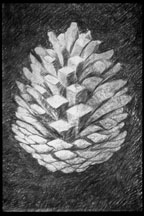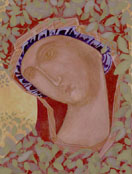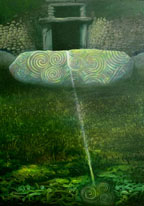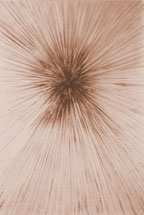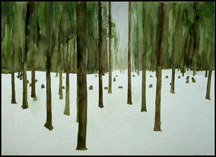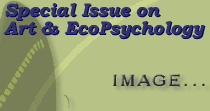

 |
 |
 |
 |
|
Interview
with Environmental Artist/Visionary
The
following article uses excerpts taken from a several-hour interview
/ conversation I had with the English-born artist in his home on
April 1st, 2000. Christopher lives in the California bay area with
his partner, Kathryn Roszak, and their 19 month-old daughter, Lucy.
Part
2 of this interview appears in the Sound
Section of this issue. Introduction The
artist’s creative output was tastefully arranged on every wall
of the room - produced in what seemed like every possible visual
medium: oils, watercolor, charcoal, pen and ink. There were etchings,
and paintings- very, very large ones and quite small ones. There
were famous sacred landscapes, and museum-quality drawings of Neolithic
art — goddess figures and intricate rock carvings. A gigantic
detailed charcoal sketch of a single pinecone hung directly across
the room from an equally large, almost Zen- minimalist image of
a pine forest. A row of architecturally delicate watercolor renderings,
of stone circles within the British landscape, overlapping what
appeared to be traces of amazingly complex musical scores, lined
still another wall. Perhaps
most intriguingly, there were several authentic-looking icons, with
their characteristic rich colors and golden halos, grouped together
in an alcove under the stairs. At first glance they seemed to be
out of place — traditional religious images of Christ and the
Madonna in the midst of this huge collection of environmentally
inspired pieces. But then I noticed the swathe of leaves crowning
Mary’s head on one of them - like a pagan ‘green woman’
peering out from the familiar vision of holy motherhood. [Later
I saw one of the first icons that Christopher ever painted- a miniature
of another leaf-bedecked goddess, entitled ‘The Madonna of
Loving Kindness to all Nature.’] I’d
just moved to California from England, myself, and was feeling terribly
homesick, so the sight of ‘green women’ and those majestic
stone circles set in the soothing lines of an English landscape
were like healing balm to me. The Castle library shelves, too, were
an affirmation that my own strange blend of English-American obsessions
and eclectic knowledge were to be found reflected somewhere here
in this new land. I knew then that I had to meet him… and was
very happy when he responded positively to my request for an interview. While planning questions for the interview, I found myself focusing on the apparent incongruity I had observed between the icons and Christopher’s other work, but as soon as he began answering, I saw the extent and limitations of my assumptions. The
Interview A)
"Did you actually go out together to look at sacred sites?" C)
"Yes, yes we did; in ones and twos, and tens and twelves on
some occasions. We didn’t really know what we were doing exactly."
A)
"What did you do?" C)
"We’d go and sit, and tune in… look for flying saucers,
stuff like that." (laughs) A)
"You said you were thinking as artists then…" C)
"Yes, visually, we were looking, looking at the places a lot,
and looking at the symbols that were imbedded in the landscape…" A)
"So when you said you were looking for the underlying mythology…?" C)
"Well, that would come later, although perhaps that (the study
of mythology) would indicate where to go… we’d find someplace
that would have some mystery attached to it, so we’d go there
and see what we felt. Then, the research and looking up any sort
of detail that there might be about that place would come later
- its story and history and the local lore around it. And then also
this whole thing of looking at maps was a big, more esoteric part
of it. Getting the ruler out and lining things up on the map, late
at night…" A)
"That’s something that Michell was into?" C)
"Yes, absolutely. Anyway,
as time went on the group of artists (from college) came under the
aegis of a group called RILKO (Research Into Lost Knowledge Organization),
that was more of a staid, conservative group of rather stiff older
types. There is a kind of esoteric movement in Britain that is like
that- I imagine by now it is pretty much rapidly dying out, but
at that time was still thriving. Ladies and gentlemen would get
together and exchange esoteric information… It turns out there
was another group of artists involved in this group, so we all got
together and started exhibiting
our work together. We
put on a touring show called ‘Earth Mysteries’ that went
on for several years in the late 70s - mid 80s… combined with
some of the documentary information about alignment and geometry
and science..."
C)
"Yes. Exactly. A)
"Where did you do your research, to know where to go? You seem
to have been hitting some sites that are not so obvious." C)
"Oh, museums and libraries… the Society of Antiquaries
Library in London was particularly helpful… Basically
I just read a lot. Trails developed out of this research… the
process of discovery is incredible. Working in libraries and then
actually going to places you’ve never been to. Searching for
places, and even coming across places that are unknown at that point;
the odd undocumented standing stone. For example, there was this
site in Portugal, called Xarez, a magnificent megalithic site -
it’s a stone square arrangement with a big pillar standing
in the middle. And it’s… just sitting out there, surrounded
by olive trees… undiscovered by archeology until 1969, or something
like that." A)
"I find it fascinating that most of the stone monuments seem
to be located in that corridor on either side of the channel - the
whole of the British Isles, and Spain, France…" C)
"You’d be surprised at the world-wide extent of Megalithic
sites. But yes, they (The European Megaliths) are along the whole
Atlantic coastline, mainly… as far south as Morocco and as
far north as Germany, Denmark, even as far east as Poland and up
into Scandinavia…" A)
"Sites in Poland? With standing stones?! " C)
"Oh yes. In Poland there are burial mounds - long tapered mounds,
with stones running all the way down their sides and a cluster of
standing stones at the wide head. About 50 yards long - there are
groups of them. My first brush with them was at a place called Wietrzychowice (pron. Vietrikoveetsa) where I asked a local farmer "Djie son grobowce?" – ‘where are the graves?’ – these were my first words in Polish, and of course the problem was deciphering the reply. But I figured out as he pointed across a ploughed field to a little copse. There I found amongst the trees about a dozen of these mounds rising like a pod of huge whales from the earth. A powerful mystery enhanced by an exquisite soft autumnal breeze in the pines and glancing sunbeams.
They
were pleased to have me, so I got a nine-month period in Poland,
and studied at the University of Warsaw, in the art department there,
printmaking. It also gave me freedom to set my own project, to travel
around Poland and look at traditions and ancient sites (Here Christopher
describes some of his adventures journeying to a series of amazing,
snow-covered Neolithic, Bronze and Iron Age stone sites, found in
formations all along the Vistula river). Fortunately
my girlfriend had family in Poland, and her aunt was a professor
of folk art studies there at Warsaw University, doing a project
on these traditional wooden, carved shrines. She was able to turn
me on to all kinds of interesting people - local experts that I
could go and talk to, who would pass me on to other professors.
And so I found myself living among the intelligentsia in Poland
in the Communist era, just before Solidarity came to power and took
over." I was privileged to go into the back rooms of many museums
and archaeological departments to handle and draw ancient objects
from their collections, stone goddesses, pots, inscribed amber disks,
this sort of thing). A)
"How fascinating! So, how did you make the link to icons? You
were being turned on to these shrines…. " C)
"There was this one particular site in Poland called Czestochowa
(pron. Chensto-hova), which is the ancient Shrine of the Black Madonna.
This was a place I had to go to, because it was a place of great
veneration for all Catholic Poles - they go on pilgrimage there
every year. So I made my own special journey there; the icon is
housed in a monastery chapel, on a hill-top called Jasna Gora (which
means white mountain). You go in there (into the chapel), and the
painting is covered, but every day they have a ceremony, during
a service, where they raise the cover and reveal the icon. And then
they close it again at the end of the service, so you have to be
there when it happens in order to see it. So
we got there, in this little chapel, not much bigger than this room
here, and it’s all bedecked with offerings; miraculous healings
have taken place there, so people have thrown away their crutches,
and left their rosaries of amber beads, etc. There were funny little
pendants with limbs made out of silver - people will leave an offering
to demonstrate a connection with a particular ailment they may wish
to have cured, like arthritis or something demonstrated by a little
silver hand, so the walls are completely covered with that kind
of thing too. And
so the place filled with up with people and the service began. A
few minutes into the service there was a big roll of drums from
up in the gallery. Literally - you hear a real drummer and a real
group of trumpeters blowing these really cracked-sounding trumpets,
like some Mexican marching band, you know. As they do this, there’s
a grinding sound as a motor raises the cover over the icon. Then
you see an incredibly ornate cover beneath that, which is silver
and gold, and jewels all over it, revealing… an incredibly
beautiful, smiling, face - very mysterious; and sort of dark as
it’s emerging. So
the service proceeds, and there’s a point in the service where
the congregation actually goes on hands and knees, together, through
a little cubbyhole, behind the altar and round, and out through
another hole. And the icon is above you - it’s as if you’re
crawling into the body of Mary and out again, becoming reborn, as
part of the ceremony." A)
"That sounds just amazing." C)
"Yes, it was unbelievable. The emotion in that place was so
heavily charged. People were sort of moaning, and there was the
sound of weeping…" A)
"That must have made an incredible impression on you…?" C)
"Oh yes, it was just amazing. It was really incredible to see.
Because I’d already studied, I mean I’d been to Malta,
where there’s a great prehistoric goddess tradition - sites
and museums full of goddess images from these goddess temples and
ensuing strong Catholic festivals for the Madonna. So I was already
tuned into the idea of feminine deity and veneration, but to see
it happen in such a graphic way, in a contemporary Catholic context,
but still somehow the same thing, was really intense and powerful. Having
seen that, I asked my professor friend in Warsaw if she knew of
any collections of icons. It turned out that in the very South East
corner of Poland, in a small town called Sanok right near the Russian
border where Poland goes down into the Carpathian hills, there was
a museum of icons; very strange, the only one in Poland. When
I finally got there (Christopher describes a harrowing journey through
the mountains in the snow, where, among other semi-hazardous delays,
he was suspected by police patrols of being a spy!) it was late
at night. So the museum director opened up the museum specifically
for me, and I had a private tour of his magnificent collection.
This was a totally new experience for me and it was at this point
that I began to realize two things about these icons: 1) that the
imagery itself is far from being just an illustration of the myth,
or the Christian story. Rather, there are incredible esoteric levels
built onto every icon - the use of landscape, for example. Where
you see a cave, it’s ‘the dark passageway into the earth’;
they are just FULL of details that I began to get really fascinated
with. So this first realization was an understanding of the esoteric,
symbolic level of the iconic imagery. And
2) I noticed that there were copies of the Black Madonna painting
throughout the art museums of Poland, by very well known artists.
It seemed as if throughout the centuries all sorts of different
artists had made copies of this painting, in different styles, using
different elaboration, and/or fairly accurate reproductions of it.
So I thought, ok, I’m going to have my turn at this, do my
version, and I did a bunch of watercolor versions, & gouache
paintings of this icon, exploring the theme. When I got back to
London, I was showing these to a friend, who said they had begun
to study with a Spanish man, called Guillem Ramos-Poqui who was
teaching icon painting, and who she thought would be interested
in seeing my work. So I took them along to the studio and showed
them to the teacher. He was interested, and suggested "Why
don’t you do the real thing?" A)
"How serendipitous! Was he using egg tempera and the whole
traditional method?" C)
"Yes. I thought, ‘this medium is so great… the colors…
the gold… really magical. I wanted to learn how to do all that,
so I spent about a year going every week to his studio (He’s
got a book out, actually, on the painting technique). There was
a group of about twelve of us… So, the first icon I did, of
course, was the Black Madonna. And
then, having done that one, I realized that I couldn’t just
go into the technical part of this without going into the whole
tradition as well… it just didn’t work for me; I would
have felt like I was ‘ripping off’ the medium. The technique
was so integrated with the whole tradition and esoteric significance
of icons in general, that I felt I would have to do some traditional
images. So, sure enough, the next one I thought I had to tackle
was THE icon - Jesus’ face. (Which I saw - Christopher still
has it in his home- the Pantocrator, it’s called: Christ as
the teacher, the power-giver and ruler of all). Two
things came out of this for me - one was that the materials themselves
were not only very interesting and beautiful, but, in the sequence
in which they are used to create an icon, they put you through a
whole alchemical process. Basically what you’re doing is using
the raw materials of the earth (the soil, and colors, which are
just pure earth), to combine the three elements - animal, vegetable
and mineral - which make up an icon. The vegetable is the wooden
panel itself, the animal is the glue that holds the base (gesso)
of your painting together, and the mineral is the pigment that you
are using, which is also combined with animal material - the egg
yolk. So, in taking these raw materials, you are taking the elements
of the earth and bringing them together into a vision that takes
you into a total leap of context. They are found as part of the
earth and you’re taking them and turning them into something
of mind and spirit, if you like. I hesitate to ever use that word,
but that’s basically what you’re doing." A)
"Like an alchemical transformation or the Catholic transubstanciation…" C)
"Yes… and in so doing, of course, you’re doing that
to yourself, which is the alchemical part. So, you’re not just
taking those elements from out there, you’re taking them from
in here. So that’s the really powerful part of it. Combine
that with the incredible power of the archetypes you’re working
with - and you have something really potent for transformation.
In the case of painting that Jesus icon, it was me working with
all the images that I had in myself - of authority, and male power,
and strength, the ‘Father’… working with all that,
and really purging it, cleansing it. ’Cause of course I had
all kinds of hang-ups about those things." A)
"Like everyone does… it’s in our culture." C)
"Yes." A)
"When you were talking, I was tying it to some work I’m
doing now on mandala… how the taking of the symbol, and putting
it into a form is kind of like that alchemical process - an elementary
magical movement, of taking one thing and transforming it into another…" C)
"Yes, and if you can combine into that the materials that you’re
using as having extra significance… that really imbues the
piece with another kind of energy. So, that’s come to play
later on in my work- with using materials.
In
the case of the mushrooms, the mushrooms were growing right outside
of where I was living in West Marin. They grew in a circle, a fairy
ring, and I watched them. I didn’t know I was going to do this,
but I watched them for days, going through their changes, and finally
they collapsed into this black pulp. At that point I realized, ‘Ah,
this can be a pigment that I can use’… so I scooped it
up with a spoon at the very last minute before it went back into
the earth, and it provided this beautiful, warm, brown color to
work with. Actually,
before that, I’d surveyed the layout of the mushrooms, the
way they’d grown, kind of like one might survey a stone circle.
I put two pegs in the ground and measured out from these two pegs,
and did a survey by triangulating this whole arrangement of mushrooms.
I was actually going to - but that comes later - the music part
comes later - but my intention was to make music from this pattern
as well. It becomes that sort of mad… you know. I guess what
I am trying to do is to uncover patterns that may not be obvious,
to reach down into pattern, and try and get at the source of what
is making this patterning. And dance with it (laughs); that’s
the fun part. Sometimes it’s a lot of work on the way, but
it’s always a great pleasure." A)
"Yes. Because if you can once find that pattern… you can
see it anywhere… it can translate from the smallest part of
anything… like fractals." C)
"Yes!" From
here we launched into a whole conversation about Christopher’s
musical works, which he has composed based on these ideas of alignment
and the sacred geometry that exists in and between all living systems.
I’ve taken some of this material and written it into a separate
article, found in the Sound
section of this issue. C)
"So anyway, that sort of brings us up to what I’ve been
doing most recently, but I still have a lot of threads going back
to the pre-historical material I started with, through visiting
and going back to England, and going to see the ancient stuff here.
I still find exploring the field of archaeology very interesting." A)
"You’ve answered one of the main questions I had for you;
how you feel about all these different creative manifestations that
are coming out of you… this is a big vision you’re holding.
There are a lot of different elements to it, and it has a lot of
different expressions. But as you speak, I can see how they link
together conceptually. From
the first time I saw your work, I could sense a unified ‘heart’
behind the themes of your work... but the icons were the only part
I wondered about, how they fit with the rest. My question was mainly
about the potential contrast between the earth-based spirituality
of your Goddess and stone circle imagery, and what in pagan terms
might be described as a religious, or ‘Sky-God’ mentality
in your traditional iconic imagery. But hearing you talk about your
experience in Poland, and your own process when you work with the
icons collapses that apparent contradiction, and brings them into
the arc of the rest of your work." C)
"Yes, that contradiction just fell apart for me when I started
doing them. As regards the various media, as you can probably tell
from what I have said, basically I am trying to take the medium
that is appropriate for the end that I am seeking. So I don’t
have a problem with shifting from one medium to another. But it
may seem a little deceptive, the idea that I’m doing all these
sorts of things; it’s not really like that. I move along from
different things, and I may return, but I’m not doing watercolor
and charcoal drawings and music and oil painting and etching all
at the same time. I’m doing these things in waves." A)
"You were talking earlier, when we spoke on the phone, about
communication being the primary purpose of art. And earlier today,
when we were talking about the icons, you mentioned experiencing
a sense of individual transformation - through your process as an
artist, painting those images with those materials in that traditional
method. But also - and perhaps I’m projecting this into what
you are saying - you seemed to be interested in another level of
transformation - in terms of people seeing it and having the experience
of transformation themselves, through the viewing or entering into
the image somehow..." C)
"Yes… well, of course there are never any guarantees in
that respect." A)
"Well, I guess I didn’t mean guarantees, I’m talking
about intention, I suppose. And interest…" C)
"Ok… I think… maybe it’s a bit arrogant to have
that as an intention… that one can ‘fix’ anything
out there. That’s where I am at now. I may not have always
thought that, but now… I think, so much the better if it does…" A)
"So do you have an intention then?" C)
"I’d certainly like to communicate through the work. That
means for my vision to be ‘read’, to be understood, and
I try to find means whereby that can happen. And hence, again, I
try to use imagery that isn’t too far off from the kind of
every-day way of seeing, so that it stretches people just a bit…
in that respect. Not everybody will be - you can never pitch it
for the entire population, but there is a kind of cultural currency
as to vision. Defined to a great extent by, and I hate to say it,
the recent history of photography and printing, and now by the electronic
media. The photographic vision, which is rather thin on dimensions,
is the one that people most easily recognize. I’m terribly upset about that, really, because it’s dull, and it has robbed people of the incredible flexibility of reality and expression. I mean, if it looks like somebody’s photograph of it, then it’s not like it should be… and that was not always the case by any means. Somebody’s vision painted, or put down in some other way, was depicting a reality that was a lot more flexible. These newer media have a lot to answer for in terms of defining our visual consciousness in this ‘flat’ way. So, I’m trying to present something that is both ‘readable’ on that level, but that also extends the media, and has some expression to it. I think it would be a disaster if art was robbed of its expressive potential…"
Christopher
Castle and Kathryn Roszak are founder- members of the ensemble performance
group Anima Mundi, which features Christopher’s compositions
and design with Kathryn’s dance and choreography (see links
at the end of Part 2 of this interview). Christopher also practices
and teaches studio sessions in traditional and alternative icon
painting out of his home in Richmond, California. You
can read more about Christopher and
view more of his work via the following links: ‘The
Unknown Goddess’; an article by Christopher Castle in Mapping
the Soul of the Land: An EcoPsychology of Place Christopher
Castle image: White Cliffs http://ecopsychology.athabascau.ca/0597/castle.htm Retrieving an Ancient Ecology: Christopher Castle’s introduction to the Art issue of the pioneering EcoPsychology journal, created in association with Hayward University academics Theodore Roszak, Mary Gomes and Allan Kanter http://ecopsychology.athabascau.ca/0597/artists.htm#castle Christopher Castle’s image and artist’s statement as an Arts & Healing Network contributor: http://www.artheals.org/artists/Castle_Christopher_28/ References: Megalithomania:
Artists, Antiquarians and Archeologists of the Old Stone Monument;
John Michell- Thames & Hudson 1982 Shamanism and The Mystery Lines: Ley Lines, Spirit Paths, Shape Shifting & Out of Body Travel; Paul Devereux, Quantum (Foulsham) 1992 |
